The science behind sunscreen and SPF
The science behind sunscreen

Decades of scientific studies have shown that sunscreen is an effective tool in preventing skin cancer.
Sunscreens protect your skin by reflecting or absorbing UV radiation, helping prevent melanoma and other skin cancers.
No sunscreen blocks all UV, but evidence shows regular use is safe and effective in Australia.
Decisions about sunscreen are based on evidence and tailored to the Australian context where the risk of skin cancer is very high.
Are sunscreens safe?
We know many Australians – whether mums and dads, young people, or seniors – have questions about sunscreen.
Rest assured, decades of research and long-term studies of sunscreen use here in Australia have found no harmful effects of regular use.
In other words, you can feel confident knowing sunscreens sold in Australia are safe to use and effective at preventing skin cancer.
In fact, there is clear evidence that regular use of sunscreens helps prevent skin cancer.
Sunscreens are regulated by the Therapeutic Goods Administration (TGA), which ensures the safety, quality and efficacy of products.
The TGA has advised that sunscreens available in Australia are safe and effective to use, and Australians should continue using sunscreen as one of five forms of sun protection.
How do sunscreens work?
The TGA does not allow sunscreens to use the term ‘sunblock’, because no sunscreen can block 100% of UV radiation.
Sunscreen ingredients work in two ways:
- Reflecting and/or
- Absorbing ultraviolet (UV) radiation to help stop it from reaching the skin.
Some sunscreens do both.
There are two main parts to all sunscreens – the active ingredients and the emulsion.
The active ingredients do the sun protection work and come in two categories: UV absorbers and UV reflectors.
- Sunscreens that use UV reflectors scatter UV radiation and are often called “mineral” or “physical” sunscreens.
- Sunscreens that use UV absorbers are commonly called “chemical” sunscreens because the ingredients undergo a chemical reaction when UV rays hit them (rather than being made from chemicals).
Typically, there’s more than one and often up to six or more active ingredients in most sunscreens. In some cases, an active ingredient can both reflect and absorb UV.
The emulsion is the lotion, milk, cream, oil, foam or gel – it’s what carries the active ingredient. It is usually made up of some combination of oil and water, plus other ingredients to help preserve the sunscreen so it lasts on the shelf or in your cupboard.
Emulsion ingredients also help with water resistance, influence how the sunscreen feels and smells, and how well it binds to the skin.
Both chemical and mineral sunscreens can be broad-spectrum, water-resistant and both deliver effective protection.
Long-term studies of sunscreen use in Australia have found no harmful effects of regular use.
Are nanoparticles in sunscreens safe?
Nanotechnology has been safely used in sunscreens for many years.
In recent years, questions have been raised about the safety of sunscreens containing nanoparticles.
Skin cancer, including melanoma and non-melanoma, is Australia's most common cancer. Regular sunscreen use has been proven to prevent squamous cell carcinomas and melanomas.
The available evidence suggests that nanoparticles used in sunscreens do not pose a risk to health.
The Therapeutic Goods Administration (TGA) conducted a review of the scientific literature in relation to the use of nanoparticles zinc oxide and titanium dioxide in sunscreens.
We continue to conduct and monitor research and welcome any new research that sheds more light on this topic.
The science behind your FAQs:
How do I safely get enough vitamin D?
When the Ultraviolet (UV) Index is 3 or above, many people maintain adequate vitamin D levels just by regular incidental exposure on most days of the week. [Find out more]
Is it true that sunscreen and cosmetics containing nanoparticles cause cancer?
Nanotechnology has been used safely in sunscreens and cosmetics for many years, with no reported harmful effects. [Get the scoop]
I heard of a recipe for natural homemade sunscreen. Do these work?
Cancer Council does not recommend making or using homemade sunscreen. Instead, leave sunscreen manufacture to the experts so you know that what you’re using is safe and effective. [Get the advice]
Do sunscreens contain endocrine disruptors?
Australian sunscreens are regulated for safety – there’s no evidence they affect your endocrine system. [Learn more]
Do face creams/moisturisers containing sunscreen increase your risk of skin cancer?
Face creams and moisturisers do not cause skin cancer. For mostly indoor days with only brief sun exposure, an SPF30 product provides adequate protection. [Read more]
Are chemical sunscreens safe to use? I've read they are toxic so I'm considering switching to organic sunscreen?
There have been rigorous scientific reviews on the safety of ingredients used in sunscreen, and there is strong evidence that the active ingredients in TGA-approved sunscreen are safe to use. [Find out more]
Find out about the research behind sunscreen.
